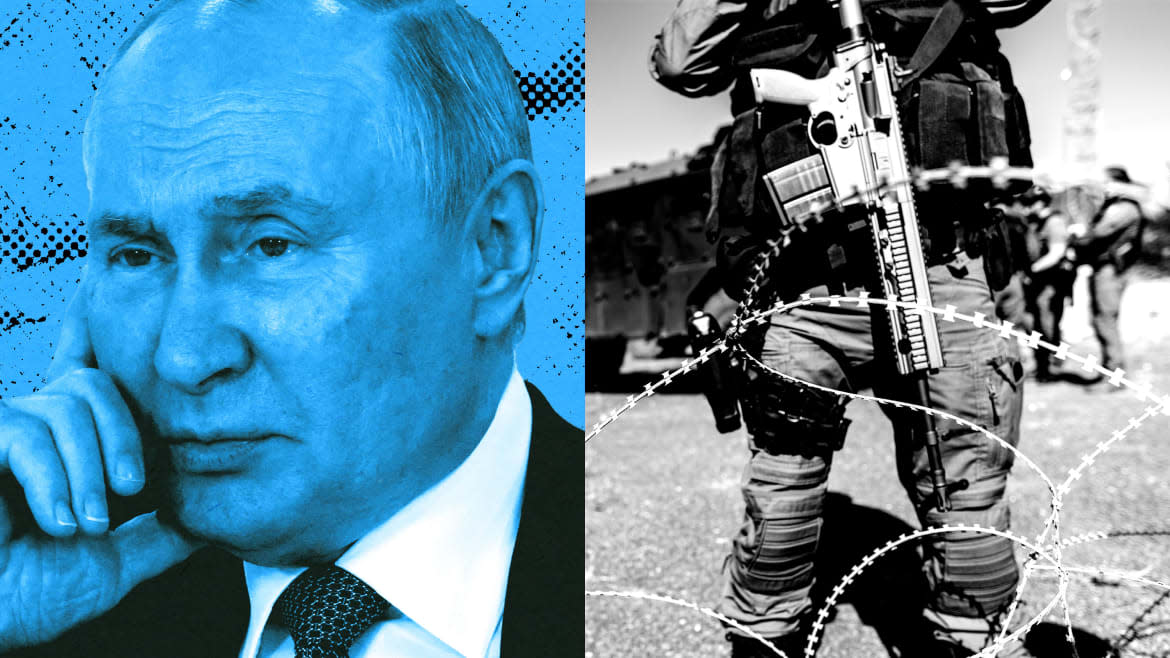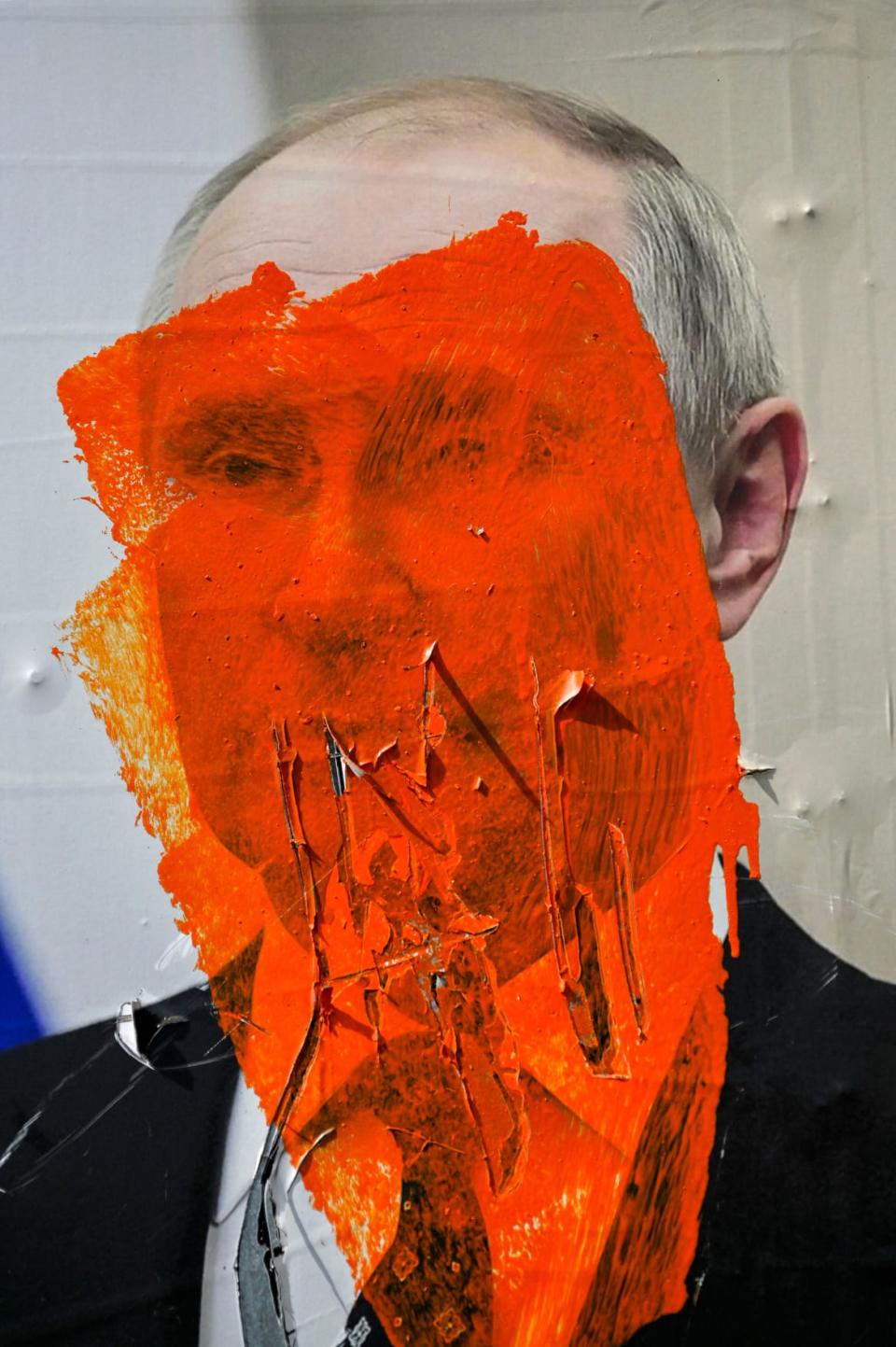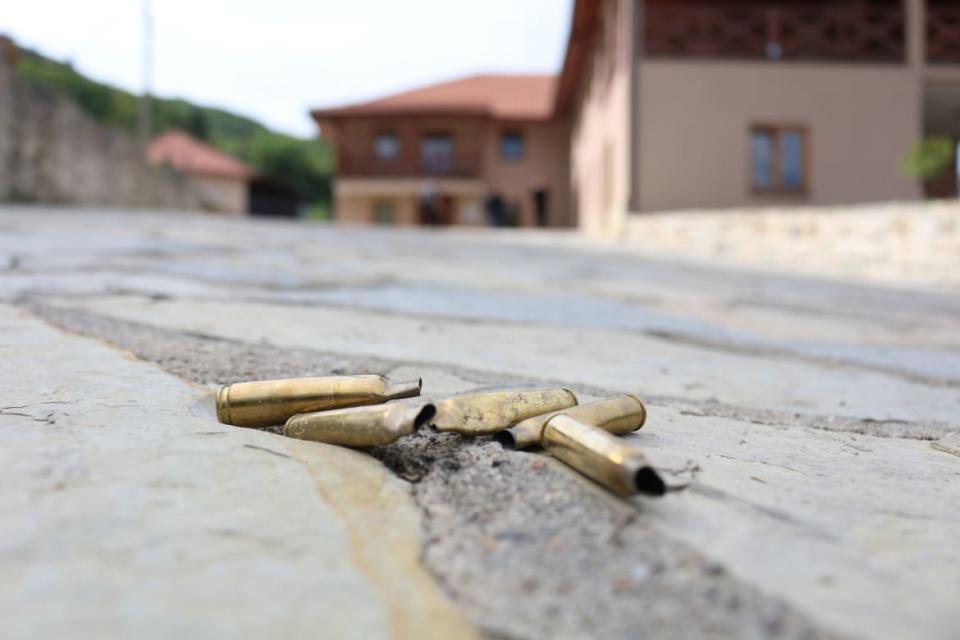A New Threat of War in Europe Has Putin’s Fingerprints All Over It

- Oops!Something went wrong.Please try again later.
The United States and NATO breathed a sigh of relief this week when the Serbian government said it would be pulling back troops after ordering a swift military buildup along its border with Kosovo. The National Security Council had referred to the buildup as “a very destabilizing development”—and news of the apparent de-escalation was “welcome,” the U.S. State Department said.
But according to officials and experts in Kosovo who spoke with The Daily Beast, only a symptom of the problem is gone. Beneath the surface, Serbian-Kosovar tensions threaten to bubble over still, with Russia stoking them behind the scenes through a vast and entrenched influence operation in Serbia.
Russian propaganda runs rampant in Serbia, spreading falsehoods and pro-Kremlin lines on territorial ambition, violence, the war in Ukraine, and NATO and the West. The sweeping Russian disinformation and propaganda operation is aimed at stoking violence and is partly aimed at propping up Serbia’s efforts to control Kosovo, Kosovo’s ambassador to the United States, Ilir Dugolli, told The Daily Beast in an exclusive interview.
“We’ve seen different attempts from Russia… and echoed of course in Serbia, about instigating violence, about portraying this… dire situation of Serbs in the northern parts of Kosovo in particular and also in other areas… to incite violent attacks and overall instability,” Dugolli told The Daily Beast.
Kosovo declared independence from Serbia in 2008, after separatist ethnic Albanians fought against Serbian rule in the late 1990s, prompting a crackdown from Belgrade. A NATO bombing campaign in 1999 eventually forced Serbian forces to withdraw from Kosovo.
Putin’s Favorite Authoritarians in Hungary, Serbia, and France Had a Great Week
But Serbia and Russia, along with a handful of countries, have not recognized Kosovo’s independence. Serbia’s current president has vowed to never recognize Kosovo’s independence, and Russia has long harbored concerns about Kosovo, noting for years that it will categorically deny Kosovo’s independence.
In recent days, those long-standing tensions have spiraled into violence.
The alarming buildup at Serbia’s border with Kosovo came in quick succession after Serb gunmen stormed a village in northern Kosovo in armed vehicles, leading to a shootout, with one police officer and several gunmen killed late last month. Kosovo accused Serbia of being behind the attack, claiming Serbia sought to destabilize Kosovo.
Serbia boasts some ties with the West—it was identified as a candidate for the European Union in 2012. But Russia’s strong influence, combined with its control over the media and the information environment in Serbia, helps to spread narratives that further entrench pro-Russia and anti-Western sentiments that keep Belgrade in Russia’s orbit.
Many news outlets in Serbia are owned by oligarchs with links to Serbian President Aleksandar Vučić, who maintains close ties with Russian President Vladimir Putin. In 2015, Russia established a hub for Russian state news agency Sputnik. Currently, Russia is in the process of deepening its channels for disinformation in Serbia: Russia’s state-funded RT said last year it would establish a local language version in Serbia, to be headed by the daughter of the editor of Sputnik.
Oozing Disinformation
The Russian narratives that have swept Serbia in recent years include anti-West and anti-NATO narratives that seek to solidify Serbian public opinion that Kosovo is not independent.
In Serbia, the focus is on reminding Serbs about NATO’s bombing campaign, and blaming the West for essentially pulling Kosovo away from Serbia, said Ruslan Stefanov, co-director and co-author of the Kremlin Playbook, a joint project of the Center for the Study of Democracy (CSD) and the Center for Strategic and International Studies.
“In the case of Serbia, the No. 1 narrative of course is, ‘Don’t forget NATO… it helped Kosovo secede. It is a part of your country,’” Stefanov told The Daily Beast. “‘This is part of NATO’s expanded campaign.’”
In recent months, some of the most popular narratives on Russian and Serbian media in the country involve Kosovo, Goran Georgiev, an analyst with CSD, said.
“The topic of Kosovo is the main topic for Sputnik and RT and also for local media, the majority of which are pro-Russian,” Georgiev told The Daily Beast.

According to data from Similarweb CSD shared with The Daily Beast, the most popular sites by traffic in Serbia are Kurir.rs—boasting 60.7 million visits in August—followed by Blic.rs, Novosti.rs, sd.rs, and RTS.rs, many of which spread pro-Russia lines. On Facebook, Sputnik and RT have garnered the most interactions in the last 30 days, according to data from CrowdTangle.
The Serbian media space is filled with mischaracterization of facts and propaganda, with Alo and Kurir.rs accounting for over half of the news spreading disinformation, according to a watchdog report from CRTA, the Center for Research, Transparency and Accountability. Večernje novosti and Informer, two dailies, are the next most egregious offenders, according to the analysis.
Sputnik in Serbia’s homepage has been brazen about Kosovo in recent days. One headline lamented that “The West’s action has never been more morbid: They do not know that the day of mourning for the Serbs lasts until freedom comes to Kosovo,” echoing a longstanding belief in Serbia that Kosovo is under a kind of “occupation.”
The piece claims the deadly attack in Kosovo represents a hatred in Kosovo towards Serbs’ lives. “Evil reigns in Kosovo,” the piece states.
In another piece, Sputnik trumped up comments from the president of the National Assembly of Serbia, Vladimir Orlić, blaming Kosovo for the soaring tensions. He “pointed out that the situation is extremely difficult” with Kosovo right now, the story noted, adding “it is solely the fault of Aljbin Kurti,” the prime minister of Kosovo.
The homepage of Kurir.rs has also paid homage to Serbia’s territorial ambition in Kosovo this week. On Wednesday, one piece focused on denying Kosovo’s independence, while noting optimism about Serbia’s effort to work with the likes of Russia and China on Kosovo and “defending” Serbia’s territory.
More broadly, narratives about territorial ambition in Serbia have closely followed Russian perspectives on violence and war. In the case of Russia’s war in Ukraine, Russian media and Serbian media have focused on spreading fake information about the war in Ukraine. Headlines such as “Ukraine started a war against Russia,” or “Ukrainian troops shelled the maternity hospital” cropped up in Serbia shortly after Russia invaded Ukraine, according to Vox Ukraine and the Centre for International Crisis and Conflict Studies (CECRI).
The Most Sincere Form of Flattery
The military buildup and violent incidents in recent days have raised questions about whether further escalation in the Balkans is on the horizon, and who is to blame.
Concern has grown in Kosovo that Russian influence has played a part. Serbia is likely taking inspiration from Russia’s effort to seize Ukraine following Putin’s invasion of Ukraine, Kosovo’s ambassador to the United States said.
“With the war in Ukraine” there was “the realization of their aspirations against my country… would kind of be easier,” Dugolli told The Daily Beast.
Serbia “mimics Russia, and tries to mimic Russia in their hegemonic aspirations by threatening the existence of neighboring countries,” Dugolli added. “They have this sort of hegemonic mindset.”
Belgrade has long been conducting military buildups at its border with Kosovo. Last year, Serbia sent troops to the border. In 2021, too, Serbia sent warplanes.
Russia’s ambassador cheered on the escalation, Kosovo claimed at the UN. Russia’s ambassador had visited a Serbian garrison at the time while it was in a state of increased combat readiness.
From Kosovo’s perspective, the longstanding aim is to create an environment where escalation is so commonplace that when an eventual territorial grab in Kosovo comes, it will look like the status quo.
“What they’ve been doing for years now is… they’ve raised the army to the highest levels several times, they’ve amassed their army at the border,” Ambassador Dugolli said. “This is one part of their plan to try to normalize threat of force, to escalate.”
In parallel efforts, disinformation on the topic has festered in Serbia. In 2020, Twitter took down a network of thousands of trolls that promoted Serbia’s ruling party and applauded its policies on Kosovo.
One of the troll army’s tweets with the most engagement noted that: “Kosovo is not a state but is part of Serbia and no compromise can be found,” according to a Stanford analysis of Twitter’s release. (Twitter and X have deleted the post about the network.)
Russian outlets in Serbia through the years have promoted stories about Kosovo being at the heart of Serbian history to promote the push to take it back. And on the flip side, media outlets close to the Serbian government have run disinformation campaigns on Kosovo in attempts to make it look like Kosovo’s westward lean was in jeopardy.
While the status of Serbia-Kosovo tensions is grave now, Dugolli said he fears the worst is yet to come.
Not Now, Europe. Second War Threatens to Explode
They are “really looking for that good moment, where they would try to destabilize entirely, try to have territorial gains,” Dugolli added. “They want to have an incursion.”
For Putin, a Serbian-Kosovar conflict may serve as a gift as his war flags in Ukraine. A flashpoint between Serbia and Kosovo could distract NATO, which maintains a peacekeeping force in Kosovo.
Ensnaring the region could also serve a larger Russian goal of keeping Serbia and Kosovo at loggerheads to help Russia project power and control in the region.
“Looking at the Kremlin playbook… I wouldn’t be surprised if it was actually caused by some desperation or sort of somebody somewhere along the line of chain of command saying, ‘Hey how about we cheer up our dear leader at some point and do something?’” Stefanov said.
Dugolli said the faltering war was likely a trigger for Serbia to take action.
“The fact that the war hasn’t gone as Russia was hoping and the leadership in Serbia were hoping as well, maybe that created an initiative… they’re trying to reposition themselves,” Dugolli said. “Russia would benefit from opening up another front.”

Russia’s interest in stirring tension between Serbia and Kosovo is rooted in broader territorial ambition as well, according to Kosovo’s president, Vjosa Osmani.
Osmani called the recent flashpoint a “Crimea-style annexation” attempt in an interview on CNN, in a reference to the Ukrainian peninsula Russia illegally annexed in 2014.
The president added she harbors concerns that Putin is pulling strings behind the scenes. The incident shows Serbia is working “to allow Putin to open a new front in the West, in the western Balkans,” Osmani said.
Puppet Master
Russia has had fertile ground in Serbia to spread the Kremlin line for years—but Belgrade has taken on a particularly unshakeable role in channeling Russian influence in recent months.
Just in the last year, the European Union banned Russian-controlled media operating in their countries since Russia invaded Ukraine. But Belgrade has not shut off the spout of Russian propaganda, allowing Serbia to serve as a key foothold for Russian influence in the region.
“Serbia has allowed the free rein of Russian propaganda,” Stefanov said, leading to a cycle of amplification among politicians, the public, and Serbian media outlets citing Russian outlets. “These same lines are parroted by major political parties… which of course amplifies that.”
The Serbian media landscape’s reach is not just local. While a majority of the traffic to Kurir.rs in August came from Serbia, for instance, over 20 percent of traffic also came from Bosnia, Montenegro, North Macedonia, and Croatia, CSD’s Georgiev noted.
“The Serbian language is a gateway to informational influence in former Yugoslavia for Serbian political actors, as well as the Kremlin,” Georgiev said.
Heavy lifting for Russian influence operations in Serbia is not always necessary.
At times, the line between where Russian disinformation and Serbian disinformation end and where organic sentiment begins can be difficult to discern. In Serbia, the disinformation space is characterized by people looking for information that reinforces their deeply ingrained beliefs about the West and Kosovo they have held for years.
On Ukraine, only 12 percent of Serbs polled said that they believed it was necessary for Russia to withdraw in order to achieve peace, echoing a classic stance from Moscow, according to a poll conducted by Datapraxis and YouGov in coordination with the Open Society Foundations last year. As many as 63 percent of Serbs polled held the West responsible for the war in Ukraine, not Russia.
The Serb public buys into opposition to Kosovo’s independence as well: 52 percent of Serbs believe Serbia should not recognize Kosovo.
“There is a lot of authentic, natural behavior mixed in,” Georgiev said.
Through the years, Russia has made a point in Serbia to execute a classic influence operation that works to juice existing sentiments and tension.
“In the case of Serbia, when you have a population that has been so heavily exposed and really bombarded with ultra-nationalistic narratives, authoritarian narratives, highly emotional narratives from the bombing to today, society adopts that whole mentality,” Georgiev said. “This information breathes for itself.”
Get the Daily Beast's biggest scoops and scandals delivered right to your inbox. Sign up now.
Stay informed and gain unlimited access to the Daily Beast's unmatched reporting. Subscribe now.

